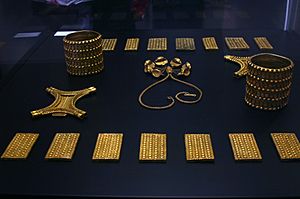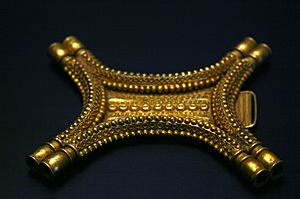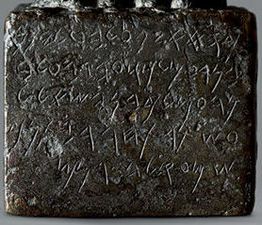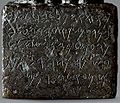Treasure of El Carambolo facts for kids
The Treasure of El Carambolo is a famous collection of ancient gold items. It was discovered on September 30, 1958, on El Carambolo hill, near the town of Camas in Spain. This spot is just 3 kilometers west of the city of Seville.
The discovery of this amazing treasure made people very interested in the ancient Tartessos culture. This culture was powerful from the 9th to the 6th centuries BCE. However, some experts now wonder if the treasure was made by the local Tartessos people or by the Phoenicians, who were skilled traders and craftspeople from the Middle East.
The treasure was found by Spanish construction workers. They were doing renovations at a pigeon shooting club when they stumbled upon it. For many years, a copy of the treasure was shown to the public while the real items were kept safe. But since January 2012, the original treasure has been on permanent display at the Archeological Museum of Seville. You can still see a replica at the National Archaeological Museum in Madrid.
Contents
What's Inside the Treasure?
The treasure is made up of 21 beautiful pieces crafted from pure gold. These include a necklace with hanging ornaments, two bracelets, two special chest plates shaped like ox hides, and 16 small gold plaques. All these golden items were carefully buried inside a ceramic pot.
The plaques might have been part of a necklace or a crown. Another idea is that they were sewn onto fabrics used to decorate animals. These animals might have been led to special ceremonies or sacrifices. The necklace and bracelets were likely worn by the priest leading these events.
After the treasure was found, archaeologist Juan de Mata Carriazo explored the site more. Experts believe most of the treasure dates back to the 8th century BCE. However, the necklace is thought to be from the 6th century BCE and might have come from Cyprus. The entire collection was probably buried on purpose in the 6th century BCE.
Uncovering Ancient Settlements
Archaeologists have found two different ancient sites at El Carambolo hill. The first site, called "Carambolo Alto," was on top of the hill. It dates from the 9th to the mid-8th century BCE. At this site, they found remains of burned huts and pottery with geometric patterns. This first site shows us what the local culture was like before the Phoenicians arrived.
The second site, known as "Carambolo Bajo," is on the side of the hill facing the river. This site dates from the mid-8th century BCE, when trade with the Phoenicians began. The Treasure of El Carambolo is connected to this second site. It might have been buried when the site was destroyed in the 6th century BCE.
The Phoenician Goddess Astarte
Between 1960 and 1962, a small bronze statue of the Phoenician goddess Astarte was also found at El Carambolo. This discovery made some experts think that the site was more Phoenician than Tartessian. Further digging showed that there was a Phoenician religious sanctuary there.
The base of the Astarte statue (which is about 4.1 x 2.8 cm) has an important Phoenician inscription. It has five lines of Phoenician writing. This statue was given to the Archeological Museum of Seville in 1963.
Where Did the Gold Come From?
In 2018, a study used special chemical and isotopic tests to try and solve the mystery of where the treasure came from. The study found that even though the jewelry was made using Phoenician techniques, the gold itself came from mines only about 20 kilometers (12 miles) away.
These mines were likely the same ones that provided gold for the huge underground tombs found at Valencina de la Concepción. This suggests a mix of local materials and foreign craftsmanship.
Images for kids
See also
 In Spanish: Tesoro de El Carambolo para niños
In Spanish: Tesoro de El Carambolo para niños





